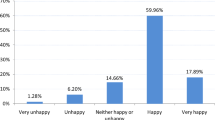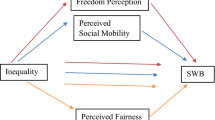Abstract
Subjective well-being analysis of income inequality finds that very high levels of objective inequality are considered “bad” in both the industrialized and emerging economies covered in the study. People from the industrialized economies appear to be more sensitive to mild levels of objective inequality compared to those from the emerging economies. Subjective inequality, on the other hand, is not considered “bad” in the same industrialized and emerging economies covered in the study. People from both areas appear to tolerate subjective inequality provided it is the outcome of an impartial environment founded upon rules observed by the majority. There, however, remains the need to help people recognize the importance of addressing inequalities in order for them to demand a more equitable distribution of income in society.
Similar content being viewed by others
Notes
Another way of looking at the components is as follows: affect is “emotional happiness” and “judgment is “evaluative happiness.” The latter is synonymous with “satisfaction” (e.g., life satisfaction). Notice that the label “happiness” refers to affect or judgment, but the conversational usage of “happiness” is really more about affect. In this paper, subjective well-being, happiness, and life satisfaction are treated as the same concepts. There is another dimension to happiness—separate from but related to affect and cognition—and it is called “eudaimonic happiness,” which is sometimes operationalized to comprise two components, namely “meaning in life” and “purpose in life”.
It is not feasible to correct for time invariant unobservable variables by, say, the first difference approach given that SWB is latent and ordinal. It is also not possible to correct for (possible) endogeneity in the model because the dataset used in the analysis in this paper is not longitudinal in nature. Country dummies can control for the idiosyncrasies within the country groupings but these were not introduced in the analysis in order not to bias the relationship between individual-level indicators and SWB. Just the same, the size of e is not expected to undermine or reverse the direction of relationship between the right- and left-hand side variables. Caution in generalizing the results is therefore well advised.
There is a negative correlation between low subjective freedom and SWB (subjective freedom quintile 2) in the industrialized economies, where objective freedom is high. This result is not found (or at least, the result is not statistically significant) for the same quintile in the emerging economies, where objective freedom is low. Perhaps, the large array of choices available to people in the industrialized economies becomes a negative freedom to people who end up feeling restrained or who cannot act on their options because their incomes cannot make them convert choices to actions. People end up blaming themselves because they cannot shape their own lives or control outcomes.
A “high Gini index” is defined as a value above 30. Admittedly, the definition is rather arbitrary.
Results on the interaction between the Gini index and a dummy representing very low levels of income inequality reveal that too little objective inequality is negatively correlated with SWB. The industrialized economies in the sample with (relatively) low Gini index are Finland (0.27), Germany (0.28), Japan (0.24), Netherlands (0.30), Norway (0.25), and Sweden (0.25). Thus, too much fairness may not raise well-being further when well-being is already at a high level.
References
Alesina, A., Di Tella, R., & MacCulloch, R. (2004). Inequality and happiness: are Europeans and Americans different? Journal of Public Economics, 88(9–10), 2009–2042.
Andrews, F., & Robinson, J. (1991). Measures of subjective well-being. In J. Robinson, P. Shaver, & L. Wrightsman (Eds.), Measures of personality and social psychological attitudes (pp. 61–114). San Diego: Academic.
Andrews, F., & Withey, S. (1976). Social indicators of well-being. New York: Plenum Press.
Blanchflower, D., & Oswald, A. (2008). Is well-being U-shaped over the life cycle? Social Science and Medicine, 66(8), 1733–1749.
Campbell, A., Converse, P., & Rogers, W. (1976). The quality of American life, New York: Sage Publications.
Clark, A., & Oswald, A. (1994). Unhappiness and unemployment. The Economic Journal, 104(424), 648–659.
Clark, A., Diener, E., Georgellis, Y., & Lucas, R. (2008). Lags and leads in life satisfaction: a test of the baseline hypothesis. The Economic Journal, 118(529), F222–F243.
Corneo, G., & Gruner, H. (2002). Individual preferences for political redistribution. Journal of Public Economics, 83(1), 83–107.
Costa, P., & McCrae, R. (1988). Personality in adulthood: a six-year longitudinal study of self-reports and spouse ratings on the NEO personality inventory. Journal of Personality and Social Psychology, 54(4), 853–863.
Csikszentmihalyi, M. (1991). Flow: The psychology of optimal experience. New York: Harper and Row.
Davidson, R. (2003). Affective neuroscience and psychophysiology: toward a synthesis. Psychophysiology, 40(5), 655–665.
Di Tella, R., & MacCulloch, R. (2006). Some uses of happiness data in economics. Journal of Economic Perspectives, 20(1), 25–46.
Di Tella, R., MacCulloch, R., & Oswald, A. (2001). Preferences of inflation and unemployment: evidence from surveys of happiness. American Economic Review, 91(1), 335–341.
Di Tella, R., MacCulloch, R., & Oswald, A. (2003). Macroeconomics of happiness. The Review of Economics and Statistics, 85(4), 809–827.
Diener, E., & Emmons, R. (1985). The independence of positive and negative affect. Journal of Personality and Social Psychology, 47(5), 71–75.
Diener, E., & Larsen, R. (1984). Temporal stability and cross-situational consistency of affective, behavioral, and cognitive responses. Journal of Personal and Social Psychology, 47(4), 580–592.
Diener, E., Gohm, C., Suh, E., & Oishi, S. (2000). Similarity of the relationships between marital status and subjective well-being across cultures. Journal of Cross Cultural Psychology, 31(4), 419–436.
Diener, E., Lucas, R., Schimmack, U., & Helliwell, J. (2009). Well-being for public policy. Oxford: Oxford University Press.
Dunn, E., Aknin, L., & Norton, M. (2008). Spending money on others promotes happiness. Science, 319(5870), 1687–1688.
Easterlin, R. (1974). Does economic growth improve the human lot? Some empirical evidence. In P. David & M. Reder (Eds.), Nations and households in economic growth: Essays in honor of Moses Abramovitz (pp. 89–125). New York: Academic.
Easterlin, R. (1995). Will raising the incomes of all increase the happiness of all? Journal of Economic Behavior and Organization, 27(1), 35–47.
Easterlin, R. (2010). Happiness, growth and the life cycle. Oxford: Oxford University Press.
Ehrhardt, J., Saris, W., & Veenhoven, R. (2000). Stability of life satisfaction over time: analysis of change in ranks in a national population. Journal of Happiness Studies, 1(2), 177–205.
Eid, M., & Larsen, R. (2008). The science of subjective well-being. New York: Guilford Press.
Ekman, P., Davidson, R., & Friesen, W. (1990). The Duchenne smile: emotional expression and brain physiology II. Journal of Personality and Social Psychology, 58(2), 342–353.
Ferrer-i-Carbonell, A., & Frijters, P. (2004). How important is methodology for the estimates of the determinants of happiness. The Economic Journal, 114(479), 641–659.
Fowler, J., & Christakis, N. (2008). Dynamic spread of happiness in a large social network: longitudinal analysis over 20 years in the Framingham heart study. British Medical Journal, 337(42), 23–27.
Frey, B., & Stutzer, A. (2002). Happiness and economics. Princeton: Princeton University Press.
Frey, B., Stutzer, A., & Luechinger, S. (2010). Life satisfaction approach to environmental valuation. Annual Review of Resource Economics, 2(1), 139–160.
Graham, C., & Felton, A. (2006). Inequality and happiness: insights from Latin America. Journal of Economic Inequality, 4(1), 107–122.
Helliwell, J., Barrington-Leigh, C., Harris, A., & Huang, H. (2010). International evidence on the social context of well-being. In E. Diener, J. Helliwell, & D. Kahneman (Eds.), International differences in well-being (pp. 291–327). Oxford: Oxford University Press.
Hooghe, M. (2012). I am happy, hope you’re happy too: examining the different dynamics of individual subjective well-being and view on society. Journal of Happiness Studies, 13(1), 17–29.
Hsee, C., & Zhang, J. (2004). Distinction bias: misprediction and mischoice due to joint evaluation. Journal of Personality and Social Psychology, 86(5), 680–695.
Inglehart, R., Foa, R., Peterson, C., & Welzel, C. (2008). Development, freedom, and rising happiness. Perspectives on Psychological Science, 3(4), 264–285.
Kahneman, D., & Sugden, R. (2005). Experienced utility as a standard of policy evaluation. Environmental and Resource Economics, 32(1), 161–181.
Kahneman, D., Diener, E., & Schwarz, N. (1999). Well-being: The foundations of hedonic psychology. New York: Russell Sage.
Krueger, A., & Schkade, D. (2008). The reliability of subjective well-being measures. Journal of Public Economics, 92(8–9), 1833–1845.
Larsen, R., & Prizmic, Z. (2008). Regulation of emotional well-being: Overcoming the hedonic treadmill. In M. Eid & R. Larsen (Eds.), The science of subjective well-being (pp. 258–289). New York: Guilford Press.
Lucas, R., Diener, E., & Suh, E. (1996). Discriminant validity of well-being measures. Journal of Personality and Social Psychology, 71(3), 616–628.
Marks, N., & Lambert, J. (1998). Marital status continuity and change among young and midlife adults: longitudinal effects on psychological well-being. Journal of Family Issues, 19(6), 652–686.
Michalos, A. (1985). Multiple discrepancies theory (MDT). Social Indicators Research, 16(4), 347–413.
Ng, Y.-K. (1996). Happiness surveys: some comparability issues and an exploratory survey based on just perceivable increments. Social Indicators Research, 38(1), 1–27.
Ng, Y.-K. (1997). A case for happiness, cardinalism, and interpersonal comparability. The Economic Journal, 107(445), 1848–1858.
O’Connell, M. (2004). Fairly satisfied: economic equality, wealth, and satisfaction. Journal of Economic Psychology, 25(3), 297–305.
Pavot, W., Diener, E., Colvin, R., & Sandvik, E. (1991). Further validation of the satisfaction with life scale: evidence for the cross-method convergence of well-being measures. Journal of Personality Assessment, 57(1), 149–161.
Sandvik, E., Diener, E., & Seidlitz, L. (1993). Subjective well-being: the convergence and stability of self-report and non-self-report measures. Journal of Personality, 61(3), 317–342.
Schimmack, U., & Oishi, S. (2005). The influence of chronically and temporarily accessible information on life satisfaction judgments. Journal of Personality and Social Psychology, 89(3), 395–406.
Schwartz, B., & Ward, A. (2004). Doing better but feeling worse: The paradox of choice. In P. Linley & S. Joseph (Eds.), Positive psychology in practice (pp. 86–104). Hoboken: Wiley.
Schwarz, N., Knauper, B., Hippler, H., Noelle-Neumann, E., & Clark, L. (1991). Rating scales: numeric values may change the meaning of scale labels. Public Opinion Quarterly, 55(4), 570–582.
Schwarz, N., Grayson, C., & Knauper, B. (1998). Formal features of rating scales and the interpretation of question meaning. International Journal of Public Opinion Research, 10(2), 177–183.
Senik, C. (2005). Income distribution and well-being: what can we learn from subjective data? Journal of Economic Survey, 19(1), 43–63.
Sheldon, K., & Lyubomirsky, S. (2006). Dynamic well-being: connecting indicators of what people anticipate with indicators of what they experience. Journal of Happiness Studies, 7(1), 55–86.
Stevenson, B., & Wolfers, J. (2008). Economic growth and subjective well-being: reassessing the Easterlin paradox. Brookings Papers on Economic Activity, 2008(1), 1–87.
Stutzer, A., & Frey, B. (2006). Does marriage make people happy, or do happy people get married? Journal of Socio-Economics, 35(2), 326–347.
Urry, H., Nitschke, J., Dolski, I., Jackson, D., Dalton, K., Mueller, C., et al. (2004). Making a life worth living: neural correlates of well-being. Psychological Science, 15(6), 367–372.
van Praag, B., & Ferrer-i-Carbonell, A. (2004). Happiness quantified: A satisfaction calculus approach. Oxford: Oxford University Press.
Watson, D., Clark, L., & Tellegen, A. (1988). Development and validation of brief measures of positive and negative affect: the PANAS scale. Journal of Personality and Social Psychology, 54(6), 1063–1070.
Winkelmann, L., & Winkelmann, R. (1998). Why are the unemployed so unhappy? Evidence from panel data. Economica, 65(257), 1–15.
Author information
Authors and Affiliations
Corresponding author
Rights and permissions
About this article
Cite this article
Beja, E.L. Subjective Well-Being Analysis of Income Inequality: Evidence for the Industrialized and Emerging Economies. Applied Research Quality Life 9, 139–156 (2014). https://doi.org/10.1007/s11482-013-9243-9
Received:
Accepted:
Published:
Issue Date:
DOI: https://doi.org/10.1007/s11482-013-9243-9




